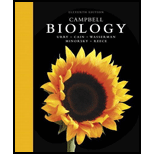
Concept explainers
Draw a phylogenetic tree illustrating our current understanding of plant phylogeny; label the common ancestor of plants and the origins of multicellular gametangia, vascular tissue, and seeds.
To draw: A phylogenetic tree that describes the relationship between the common ancestor of plants and the origins of multicellular gametangia, vascular tissue, and seeds.
Introduction: About 1.2 billion years ago, the microorganisms colonized on the land surface. The microscopic fossils are the shreds of evidence of life on the Earth. These spore fossils are estimated to be 450 million years old. These spores are different from spores of algae and fungi of the present day in terms of their chemical composition. Cooksonia sporangium is one of the biggest fossils of the larger plants that occurred about 435 million years ago. Then a third clade of seed plants occurred that is defined today as the gymnosperm and the angiosperm.
Explanation of Solution
Pictorial representation: Fig.1 shows the phylogenetic tree drawn to represent the relationship between different groups of land plants.

Fig.1 Phylogenetic tree
Fossils show that the origin of plants occurred about various million years ago. Plants then divided into various groups like the Bryophytes (non-vascular plants), which include liverworts, mosses, and hornworts. Then about 430 million years ago the origin of seedless vascular plants occurred, which includes lycophytes (spike mosses, and quillworts) and monilophytes (fern, horsetail, and whiskfern). Around 360 million years ago various seed plants originate that including angiosperm as well as the gymnosperm, occurred. The Fig.1 shows the phylogenetic relationship between the four groups of the plant.
There are some characteristics that differentiate these four groups of plants are as follows:
- Bryophytes (mosses): The vascular system is absent, the gametophyte stage is dominant, having spores, and have motile sperm
- Pteridophytes (ferns): Vascular system present, dominant sporophyte system, reproduction through spores, and motile sperm is present.
- Gymnosperm (Pines, Spruce, and Gingko): They also have a vascular system with sporophyte as the dominant stage and the reproduction occurs by either heterospory, cones, pollen, eggs, or seeds.
- Angiosperm (monocot and dicots): The vascular system is present and the sporophyte stage is dominant in sporophytes.
Want to see more full solutions like this?
Chapter 29 Solutions
Campbell Biology (11th Edition)
- Amino Acid Coclow TABle 3' Gly Phe Leu (G) (F) (L) 3- Val (V) Arg (R) Ser (S) Ala (A) Lys (K) CAG G Glu Asp (E) (D) Ser (S) CCCAGUCAGUCAGUCAG 0204 C U A G C Asn (N) G 4 A AGU C GU (5) AC C UGA A G5 C CUGACUGACUGACUGAC Thr (T) Met (M) lle £€ (1) U 4 G Tyr Σε (Y) U Cys (C) C A G Trp (W) 3' U C A Leu בוט His Pro (P) ££ (H) Gin (Q) Arg 흐름 (R) (L) Start Stop 8. Transcription and Translation Practice: (Video 10-1 and 10-2) A. Below is the sense strand of a DNA gene. Using the sense strand, create the antisense DNA strand and label the 5' and 3' ends. B. Use the antisense strand that you create in part A as a template to create the mRNA transcript of the gene and label the 5' and 3' ends. C. Translate the mRNA you produced in part B into the polypeptide sequence making sure to follow all the rules of translation. 5'-AGCATGACTAATAGTTGTTGAGCTGTC-3' (sense strand) 4arrow_forwardWhat is the structure and function of Eukaryotic cells, including their organelles? How are Eukaryotic cells different than Prokaryotic cells, in terms of evolution which form of the cell might have came first? How do Eukaryotic cells become malignant (cancerous)?arrow_forwardWhat are the roles of DNA and proteins inside of the cell? What are the building blocks or molecular components of the DNA and proteins? How are proteins produced within the cell? What connection is there between DNA, proteins, and the cell cycle? What is the relationship between DNA, proteins, and Cancer?arrow_forward
- please fill in the empty sports, thank you!arrow_forwardIn one paragraph show how atoms and they're structure are related to the structure of dna and proteins. Talk about what atoms are. what they're made of, why chemical bonding is important to DNA?arrow_forwardWhat are the structure and properties of atoms and chemical bonds (especially how they relate to DNA and proteins).arrow_forward
- The Sentinel Cell: Nature’s Answer to Cancer?arrow_forwardMolecular Biology Question You are working to characterize a novel protein in mice. Analysis shows that high levels of the primary transcript that codes for this protein are found in tissue from the brain, muscle, liver, and pancreas. However, an antibody that recognizes the C-terminal portion of the protein indicates that the protein is present in brain, muscle, and liver, but not in the pancreas. What is the most likely explanation for this result?arrow_forwardMolecular Biology Explain/discuss how “slow stop” and “quick/fast stop” mutants wereused to identify different protein involved in DNA replication in E. coli.arrow_forward
 Biology: The Dynamic Science (MindTap Course List)BiologyISBN:9781305389892Author:Peter J. Russell, Paul E. Hertz, Beverly McMillanPublisher:Cengage Learning
Biology: The Dynamic Science (MindTap Course List)BiologyISBN:9781305389892Author:Peter J. Russell, Paul E. Hertz, Beverly McMillanPublisher:Cengage Learning Biology 2eBiologyISBN:9781947172517Author:Matthew Douglas, Jung Choi, Mary Ann ClarkPublisher:OpenStax
Biology 2eBiologyISBN:9781947172517Author:Matthew Douglas, Jung Choi, Mary Ann ClarkPublisher:OpenStax Concepts of BiologyBiologyISBN:9781938168116Author:Samantha Fowler, Rebecca Roush, James WisePublisher:OpenStax College
Concepts of BiologyBiologyISBN:9781938168116Author:Samantha Fowler, Rebecca Roush, James WisePublisher:OpenStax College Biology (MindTap Course List)BiologyISBN:9781337392938Author:Eldra Solomon, Charles Martin, Diana W. Martin, Linda R. BergPublisher:Cengage Learning
Biology (MindTap Course List)BiologyISBN:9781337392938Author:Eldra Solomon, Charles Martin, Diana W. Martin, Linda R. BergPublisher:Cengage Learning Biology Today and Tomorrow without Physiology (Mi...BiologyISBN:9781305117396Author:Cecie Starr, Christine Evers, Lisa StarrPublisher:Cengage Learning
Biology Today and Tomorrow without Physiology (Mi...BiologyISBN:9781305117396Author:Cecie Starr, Christine Evers, Lisa StarrPublisher:Cengage Learning





